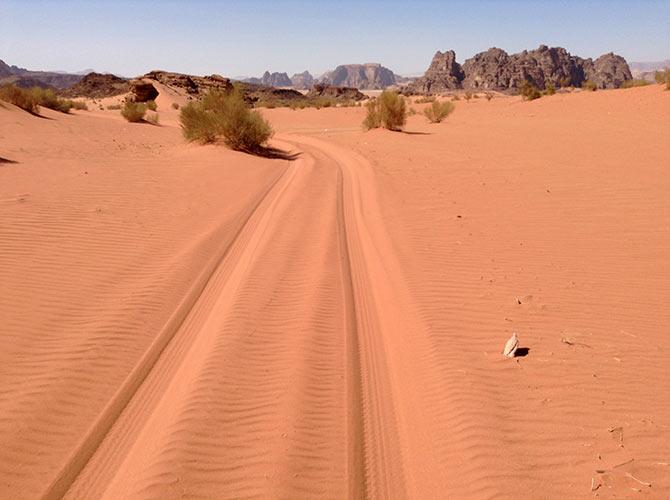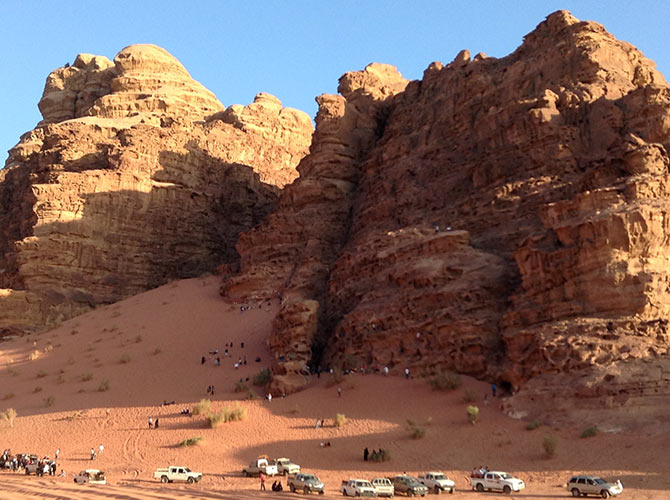There were no tracks that we could see and no landmarks in the distance to which he was pointing the vehicle to. We were getting deep into the desert and there was not a soul between us and the horizon. The road disappeared and we were surrounded by old, craggy red rocks, the kind I suppose you would expect to see on, well, Mars.
Sandeep Sreedharan shares his wonderful visit to Wadi Rum, a vast desert area in southern Jordan that resembles the Red Planet.
Wikipedia says Wadi Rum is spread over 720 square kilometers. If you have seen the recently released Matt Damon starrer ‘The Martian’ or even caught the trailer, you should know that Wadi Rum stood in for a number of scenes set on the red planet.

It is apt that it did so. For when you enter the Wadi Rum protected area, the thing that strikes you is the redness of it all.
When we decided on the spur of the moment to visit Jordan during a long weekend in April, our focus was on the usual sights of Jerash, Petra and the Dead Sea. Wadi Rum kept cropping up on various itineraries on the internet but hey, we lived in Dubai. Why would we travel from a desert to see another desert? But whenever I put this statement out to friends who had visited Jordan, instead of them laughing at the irony, all I got was sincere advice to not miss Wadi Rum. Thus coerced by well-meaning peers, we included Wadi Rum into our plans for the last day.
We would drive down from Petra to reach Wadi Rum in the late afternoon, stay overnight at one of the desert camps that seemed to dot the area and drive back to Amman the next day after breakfast in time to catch our return flight.

The day started early for us as we traipsed in and around Petra, walking over rocks big and small, scrambling up to the High Place of Sacrifice for sublime views over the ancient city and wondering at the beauty that man had wrought so many centuries ago. We had lunch at one of the two restaurants inside Petra before exiting through the narrow canyon for our ride to Wadi Rum.
It is about a two hour drive to Wadi Rum from Petra, or Wadi Musa as the town outside Petra is called. It was a gentle drive over mostly flat terrain as we marvelled at how we had travelled down from the heights of Amman (3,000 feet) to the depths of the Dead Sea (-1,400 feet) and now had climbed back to almost similar elevations in Petra (2,600 feet).
Jordan’s undulations were captivating. There wasn’t any traffic and the road stretched out towards the horizon with even road signs taking care not to disturb the view. It was almost 4 in the afternoon when we pulled into the conservation area, which is essentially a couple of squat buildings with ample car parking in a large clearing, dwarfed by red sandstone hills.
We connected with our guide, Nadjah; bid goodbye to our driver Mustafa and transferred our bags into Nadjah’s old pick-up truck. We paid the entrance fees of 5JD each and followed Nadjah towards his truck. I was wondering if we would fit into the little cab when he gestured us towards the back. Ah, we were going to be ferried as cargo, little realising then that the only way to experience Wadi Rum was to be outside.
We drove out of the parking and for a little while on the tarmac. But soon, Nadjah swung off the road and into the desert.
There were no tracks that we could see and no landmarks in the distance to which he was pointing the vehicle to. We were getting deep into the desert and there was not a soul between us and the horizon. The road disappeared and we were surrounded by old, craggy red rocks, the kind I suppose you would expect to see on well, Mars.
The hills were fissured and pockmarked by the ages and allowed our imaginations to see camels and warriors and turtles and horses. Out came the ipad.
We drove for about 20 minutes till we reached a small clearing in the shadow of a hill. There were about 6 tents arranged in a circle with a long tent just outside the circle. This was the communal tent where we were welcomed by Nadjah’s cousins who poured us our first glass of hot, refreshing sage tea. Our tent was warm with the outer black fabric having absorbed all the heat of the day, so we simply dropped our bags there, had a quick glug of water and it was back to the main tent for some more of that tea. After a couple of little glasses of satisfaction, we set out again with Nadjah to visit his 720 square kilometer home, the Wadi Rum.
When one takes photographs, one tries to capture the moment forever. By doing so, the hope is to keep the memory of that moment within grasp. When I go over all the photos that we took during that drive, I see a lot of red rocks and I realise the futility of trying to capture the immensity of what we see within the puny lens of the camera. But what those photographs do is remind me of the vast and silent beauty of Wadi Rum. Somehow, the inability of the camera to translate all that we experienced into its two dimensional output allows the eye of memory to fill in the other dimensions and elevate the scale close to what it really was.
There were breaks in that 3 hour drive, breaks to write our names in the sand, to sip more of that sage tea at a friend’s tent, to peer at some old rock carvings, to climb up a sand dune and sit for a while on the cool sand while watching kids roll down the dunes, to ogle at what seemed to be an organised walk or run through the Wadi and wonder at the motivation of the participants, to wave at a couple of tourists traversing the desert on camels, but the best break was when we climbed up a small hill to sit back and watch the sun go down.
It was dark by the time we got back to the camp. They gave us rechargeable emergency lights that allowed us to go wash off the day’s tiredness at the common showers a few meters away from our tent. Thus refreshed, we came down to the main tent for a pre-dinner catching up. The camp was empty save for us and another couple. Being located as it were, in the middle of nowhere, the feeling of isolation was complete. Lack of wi-fi signals made it even better. Sometime later, Nadjah asked us if we would like to witness our dinner being dug out.
We followed him outside to see his cousins excavating out of the hot sand a large vessel piled above and below with hot coals. Our dinner had been cooking inside this for a few hours now.
Dinner was a simple affair and yet very filling. Meat and vegetables cooked underground to such flavour, retaining their innate textures and deliciousness, were complemented by simple bread and stews. Going for seconds was not only encouraged but also necessary.

The desert sky at night is a marvel. Millions of pin pricks of light, some larger than others, some steady while others twinkle, some still while others move; one could stare at them till the eyes water. May be our awe at this spectacle was what moved Nadjah to ask if we wanted to sleep under the stars, outside the tent. We leapt at the suggestion and his team arranged it with efficient alacrity. We set up right outside our tent, huddled up in our thick blankets, reading a few pages with the portable lamps while watching the star-studded sky slowly shift above us. It was a blissful night, though we kept waking up every few hours to watch the sky with awe.
Breakfast in the morning was again simple, with multiple glasses of the sage tea that we had also learnt to smile and call ‘bedouin whisky’. We were soon all set to leave for the crowds and man-made world of roads and automobiles and noise, all set but wistful about leaving this spectacular world behind, this landscape that was quite other-worldly. And then we learn that a number of movie directors have had exactly the same idea, the latest one being Ridley Scott.



Leave a reply